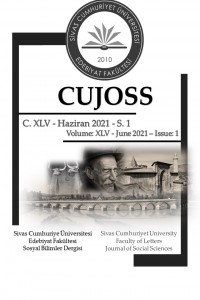THE ROLE OF SCIENCE, TECHNOLOGY AND APOCALYPSE IN THE DYSTOPIAN FICTIONS: MARY SHELLEY'S FRANKENSTEIN AND ALDOUS HUXLEY'S BRAVE NEW WORLD
Abstract
This study aims to focus on the concepts of science, technology, and apocalypse in dystopian novels. Dystopian fiction has lately become an important literary genre within speculative fiction in English and Contemporary World Literature. It is not possible to think of dystopian fiction apart from the utopian tradition, which has a long oral and written history. Therefore, In this study, after focusing on the similarities and differences of dystopian and utopian fiction, Mary Shelley's Frankenstein and Aldous Huxley's Brave New World, both of which contributed to the development of dystopian fiction as a subgenre of science fiction, will be discussed separately. Actually, it will be argued not only how both authors deal with science, technology, and apocalyptic elements in their novels but also how they criticize their own societies through the dystopian vision of these works. Moreover, the societies depicted by Shelley and Huxley will be debated to demonstrate the visible or invisible ties to the 'authority', which is thought to be the potential perpetrator of the feelings of fear, suffering and helplessness that permeate the societies.
Keywords
Dystopia Technology Science Apocalypse Aldous Huxley Mary Shelley Frankenstein Brave New World.
References
- Barr, B. (2010). Aldous Huxley's Brave New World—still a Chilling Vision After All These Years. Michigan Law Review, 108(6), 847-857. Retrieved March 11, 2021, from http://www.jstor.org/stable/40645848
- Britton, R. (2015). Mary Shelley's Frankenstein: what made the Monster monstrous?. The Journal of analytical psychology, 60(1), 1–11. https://doi.org/10.1111/1468-5922.12126
- Castleman, R. (1994). Apocalypse. MoMA, (18), 6-11. Retrieved March 14, 2021, from http://www.jstor.org/stable/4381271
- Dutoit, T. (1994). Re-Specting the Face as the Moral (of) Fiction in Mary Shelley's Frankenstein. MLN, 109(5), 847-871. doi:10.2307/2904709
- Gordin, M. D., Tilley, H. L., & Prakash, G. (2010). Utopia/dystopia: Conditions of historical possibility. Princeton, NJ: Princeton University Press.
- Huxley, A. (1998). Brave New World. New York: HarperPerennial.
- Morgan, S., Shanahan, S., & Welsh, W. (2005). Brave New Worlds: Philosophy, Politics, and Science in Human Biotechnology. Population and Development Review, 31(1), 127-144. Retrieved April 10, 2021, from http://www.jstor.org/stable/3401441
- Potter, G. (2012). Imaginaries and Realities, Utopia and Dystopia. Alternate Routes: A Journal of Critical Social Research, 23. Retrieved from http://www.alternateroutes.ca/index.php/ar/article/view/15869
- Shelley, M. (2011). Frankenstein. İstanbul: Dejavu Prints.
- Woiak, J. (2007). Designing a Brave New World: Eugenics, Politics, and Fiction. The Public Historian, 29(3), 105-129. doi:10.1525/tph.2007.29.3.105
- Seabury, M. B. (2008). The Monsters We Create: Woman on the Edge of Time and Frankenstein. In T. Burns (Ed.), Children's Literature Review (Vol. 133). Gale. (Reprinted from Critique, 2001, Winter, 42[2], 131-143) https://link.gale.com/apps/doc/PDEOCU016794808/LCO?u=ege&sid=LCO&xid=25a464ac
THE ROLE OF SCIENCE, TECHNOLOGY AND APOCALYPSE IN THE DYSTOPIAN FICTIONS: MARY SHELLEY'S FRANKENSTEIN AND ALDOUS HUXLEY'S BRAVE NEW WORLD
Abstract
Bu çalışma, İngiliz ve çağdaş dünya edebiyatında önemli bir edebi gelenek haline gelen distopyalarda bilim, teknoloji ve kıyamet kavramlarının rolü üzerine odaklanmayı amaçlamıştır. Distopya türünde yazılan eserleri, sözlü ve yazılı olmak üzere uzunca bir tarihe sahip olan ütopya geleneğinden bağımsız olarak düşünmek mümkün değildir. Bu sebeple, bu çalışma içerisinde, her iki türün kavramsal benzerlikleri ve farklılıkları açıklandıktan sonra distopik kurgunun bilim kurgunun bir alt türü olarak gelişmesine katkıda sağlayan Mary Shelley'nin Frankenstein’ı ve Aldous Huxley'nin Cesur Yeni Dünya’sı ayrı ayrı incelenecektir. Bu inceleme yapılırken ise, her iki yazarın bilim, teknoloji ve kıyamet unsurlarını bu romanlarda nasıl ele aldığına değinilecek ve bu kavramlar üzerinden içinde bulundukları toplumlara yönelik ortaya koydukları bakış açısı ve eleştiriler de irdelenecektir. Aynı zamanda, hem Shelley’nin hem de Huxley’nin tasvir ettiği toplumlar ve bu toplumlara nüfuz etmiş korku, ıstırap ve çaresizlik duygularının potansiyel fail olduğu düşünülen ‘otorite’ ile görünür veya görünmez bağları tartışılacaktır.
References
- Barr, B. (2010). Aldous Huxley's Brave New World—still a Chilling Vision After All These Years. Michigan Law Review, 108(6), 847-857. Retrieved March 11, 2021, from http://www.jstor.org/stable/40645848
- Britton, R. (2015). Mary Shelley's Frankenstein: what made the Monster monstrous?. The Journal of analytical psychology, 60(1), 1–11. https://doi.org/10.1111/1468-5922.12126
- Castleman, R. (1994). Apocalypse. MoMA, (18), 6-11. Retrieved March 14, 2021, from http://www.jstor.org/stable/4381271
- Dutoit, T. (1994). Re-Specting the Face as the Moral (of) Fiction in Mary Shelley's Frankenstein. MLN, 109(5), 847-871. doi:10.2307/2904709
- Gordin, M. D., Tilley, H. L., & Prakash, G. (2010). Utopia/dystopia: Conditions of historical possibility. Princeton, NJ: Princeton University Press.
- Huxley, A. (1998). Brave New World. New York: HarperPerennial.
- Morgan, S., Shanahan, S., & Welsh, W. (2005). Brave New Worlds: Philosophy, Politics, and Science in Human Biotechnology. Population and Development Review, 31(1), 127-144. Retrieved April 10, 2021, from http://www.jstor.org/stable/3401441
- Potter, G. (2012). Imaginaries and Realities, Utopia and Dystopia. Alternate Routes: A Journal of Critical Social Research, 23. Retrieved from http://www.alternateroutes.ca/index.php/ar/article/view/15869
- Shelley, M. (2011). Frankenstein. İstanbul: Dejavu Prints.
- Woiak, J. (2007). Designing a Brave New World: Eugenics, Politics, and Fiction. The Public Historian, 29(3), 105-129. doi:10.1525/tph.2007.29.3.105
- Seabury, M. B. (2008). The Monsters We Create: Woman on the Edge of Time and Frankenstein. In T. Burns (Ed.), Children's Literature Review (Vol. 133). Gale. (Reprinted from Critique, 2001, Winter, 42[2], 131-143) https://link.gale.com/apps/doc/PDEOCU016794808/LCO?u=ege&sid=LCO&xid=25a464ac
Details
| Primary Language | English |
|---|---|
| Journal Section | Articles |
| Authors | |
| Publication Date | June 29, 2021 |
| Published in Issue | Year 2021 Volume: 45 Issue: 1 |
.

